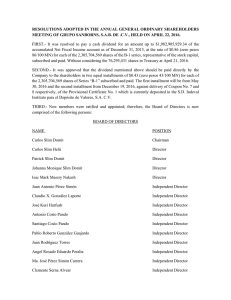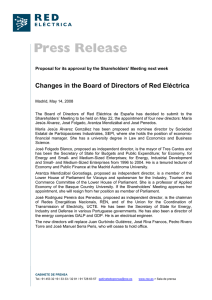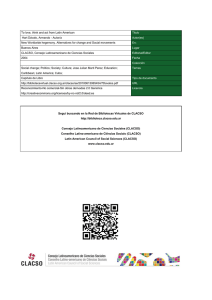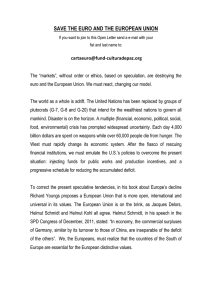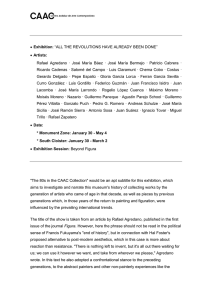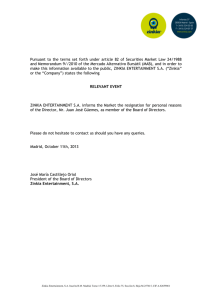OUR AMERICA” AS AN EDUCATIONAL PLATFORM IN OUR
Anuncio
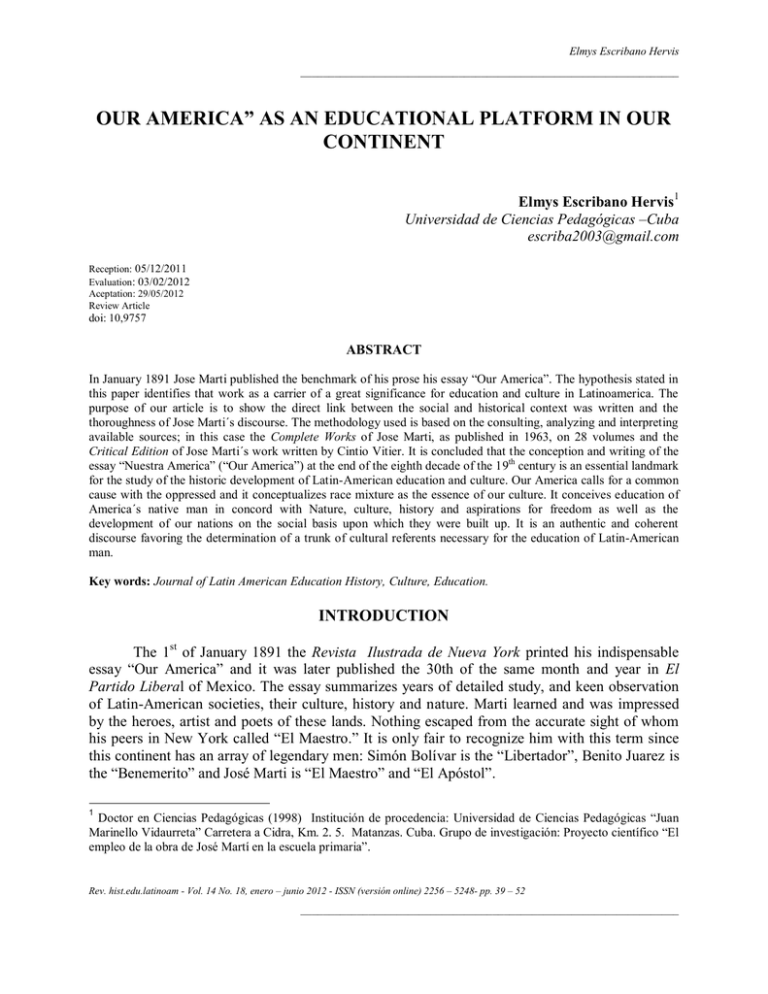
Elmys Escribano Hervis ___________________________________________________________________ OUR AMERICA” AS AN EDUCATIONAL PLATFORM IN OUR CONTINENT Elmys Escribano Hervis1 Universidad de Ciencias Pedagógicas –Cuba escriba2003@gmail.com Reception: 05/12/2011 Evaluation: 03/02/2012 Aceptation: 29/05/2012 Review Article doi: 10,9757 ABSTRACT In January 1891 Jose Marti published the benchmark of his prose his essay “Our America”. The hypothesis stated in this paper identifies that work as a carrier of a great significance for education and culture in Latinoamerica. The purpose of our article is to show the direct link between the social and historical context was written and the thoroughness of Jose Marti´s discourse. The methodology used is based on the consulting, analyzing and interpreting available sources; in this case the Complete Works of Jose Marti, as published in 1963, on 28 volumes and the Critical Edition of Jose Marti´s work written by Cintio Vitier. It is concluded that the conception and writing of the essay “Nuestra America” (“Our America”) at the end of the eighth decade of the 19th century is an essential landmark for the study of the historic development of Latin-American education and culture. Our America calls for a common cause with the oppressed and it conceptualizes race mixture as the essence of our culture. It conceives education of America´s native man in concord with Nature, culture, history and aspirations for freedom as well as the development of our nations on the social basis upon which they were built up. It is an authentic and coherent discourse favoring the determination of a trunk of cultural referents necessary for the education of Latin-American man. Key words: Journal of Latin American Education History, Culture, Education. INTRODUCTION The 1st of January 1891 the Revista Ilustrada de Nueva York printed his indispensable essay “Our America” and it was later published the 30th of the same month and year in El Partido Liberal of Mexico. The essay summarizes years of detailed study, and keen observation of Latin-American societies, their culture, history and nature. Marti learned and was impressed by the heroes, artist and poets of these lands. Nothing escaped from the accurate sight of whom his peers in New York called “El Maestro.” It is only fair to recognize him with this term since this continent has an array of legendary men: Simón Bolívar is the “Libertador”, Benito Juarez is the “Benemerito” and José Marti is “El Maestro” and “El Apóstol”. 1 Doctor en Ciencias Pedagógicas (1998) Institución de procedencia: Universidad de Ciencias Pedagógicas “Juan Marinello Vidaurreta” Carretera a Cidra, Km. 2. 5. Matanzas. Cuba. Grupo de investigación: Proyecto científico “El empleo de la obra de José Martí en la escuela primaria”. Rev. hist.edu.latinoam - Vol. 14 No. 18, enero – junio 2012 - ISSN (versión online) 2256 – 5248- pp. 39 – 52 ___________________________________________________________________ Elmys Escribano Hervis ___________________________________________________________________ “Our America” is a legitimate expression of Marti’s unique teachings and unquestionable apostolate. Wrapped in a exquisite florid and poetic prose, the essay is a profound analysis of Latin-American society at the end of the XIX century that debated itself in the face of perils and challenges, urged by circumstances and the weight of history. Marti’s vision is an essential platform to understand the cultural and educational problems of yesterday and today. Establishing the relationships between history and education on one side, and on the other side the projects of social change used until today constitute a lesson of incomparable value nowadays, this analysis of the reality, is didactic but of course, that was never his intention. “Our America”, by Jose Marti, is the conceptual consecration of our existence, is the impulse, the challenge, the reason guided by finesse and poetry; is the dream, the vigilance, and the passion of Latin-Americans. 1. The epoch and contradictions of the turn of the XIX Century The XIX Century, in Latin-America was a boiling pot of ideas, of the most diverse tendencies and objectives. Different social projects fed on this complexity that reached its peak on the second half of that century. After closing the independence chapter of colonies in Latin America, finding the path towards development and the total consecration of man’s freedom was one of the most cherished aspirations involving the most outstanding members. In the frame of that process, came in positivism into the continent, favored by a political trend of liberal orientation. The “Order and Progress” slogan seemed the right solution in countries where stagnation and colonial sclerosis that slowed down the longed development of Latin American countries. A strong thesis questioned the rational capacity of the men natural to this land, and their possibilities of having an autonomous and independent government and development. At the rescue of this trend came racist and biologically proven positions that eventually became more radical and applied to society a distorted approach of Darwin’s theory. To promptly achieve the target of development, the national oligarchies that got to power, appealed to the imitation of the old and cultivated European life, mostly its French expression on one side, and on the other some thought of copy-cabling the industrious United Stated as solution to Latin-American problems. The social classes that led the changes of that era, chose, in the name of civilization, to discriminate against the “inferior races” that they considerated mentally defective and barbaric. Domingo Faustino Sarmiento, wrote in Chile his woks “Facundo”, in which he reflects the events in Argentina from the times of independence and contradiction “[...] between civilization (sheltered in cities, and a potential for power and progress) and life in the Pampa, with its coarse inhabitants (gauchos) that are the living example of the blind chaos of nature. The hope of progress in Argentina identified itself with educational program of national reconstruction, that would bridge the gap between civilized society and the marginal from the Rev. hist.edu.latinoam - Vol. 14 No. 18, enero – junio 2012 - ISSN (versión online) 2256 – 5248- pp. 39 – 52 ___________________________________________________________________ Elmys Escribano Hervis ___________________________________________________________________ provinces, gaucha.( Sarmiento also tried to apply that program during his presidential term, in the period 1868-1874.”)2. Off the pen and the mind of Sarmiento come into being infamous racist ideas, since for him Latin American was “a bunch of wretched races, in a huge continent neglected to progress incapable salvages”3 He went further to say: “Colocolo, Lautaro, Caupolican, albeit the noble and civilized costumes bestowed into them by Ercilla, are nothing but loathsome Indians that we would have hanged now, if they showed up in a war of the Arawaks against Chile, that has nothing to do with that rabble”4. Jose Marti, who opposed to Sarmiento thesis about the contradictions between civilization and barbarity, set very clearly that “The struggle is not between civilization and barbarity, but between false erudition and Nature”5. According to Marti, Sarmiento’s ideas are the expressions of a colonialist vision of society and history. For the “Apostol” “… civilization is the vulgar term used by the current state of the European men, and that is entitled by natural right to seize land reigned by barbarity, which is the term given by those who want other people’s land in places other than Europe or the European America”6. At the service of colonialist efforts emerged the theories to justify the plundering7. Some referred to the incapacity or certain races to govern themselves, and they also wrote of their being prove to vice and laziness, according to that logic the problem lies in the genes and thus making it necessary to repeople the continent with rational, superior races capable of developing industry, trade and agriculture8. In other words the essential dilemma hinged on rejecting who we are to be like others, or hold on to authenticity, creativity and the legitimacy of our culture as the path to freedom and development viable9. 2. Perception of man in “Our America” One of the merits of “Our America” is, undoubtedly, developing a thesis for political, social, educational and cultural development anchored in the open recognition of the men that inhabit 2 Mentor Interactivo Enciclopedia de Ciencias Sociales. Barcelona (España) : Edit. Océano. (s. a.), 227. Roberto Fernández Retamar, Todo Calibán (La Habana, Fondo Cultural del ALBA, 2006), 50 4 Fernández, “Todo Calibán, 51”. 5 José Martí Pérez, Obras Completas (La Habana, Edit. Nacional de Cuba, 1963), T. VI, 17 6 O. C. Edit Cit. T. VIII, 442. 7 Este fragmento de “Las ruinas indias” resulta ilustrativo: “La superstición y la ignorancia hacen bárbaros a los hombres en todos los pueblos. Y de los indios han dicho más de lo justo en estas cosas los españoles vencedores, que exageraban o inventaban los defectos de la raza vencida, para que la crueldad con que la trataron pareciera justa y convincente al mundo.” José Martí Pérez, La Edad de Oro (La Habana: Edit. Gente Nueva, S. A.), 85. 8 Juan Bautista Alberdi. Ideas para presidir la confección del curso de Filosofía contemporánea. En: Pensamiento positivista latinoamericano. Tomo I. Compilación. Prólogo y cronología Leopoldo Zea. Caracas: Biblioteca Ayacucho. 1980 : 61 – 67 9 Leopoldo Zea. “La Cultura latinoamericana y su sentido libertario”. En Problemas 4. Identidad latinoamericana. Enfoques filosófico – literarios. Sel. Enrique Ubieta Gómez. La Habana: Ed. Academia, 1994. 3 Rev. hist.edu.latinoam - Vol. 14 No. 18, enero – junio 2012 - ISSN (versión online) 2256 – 5248- pp. 39 – 52 ___________________________________________________________________ Elmys Escribano Hervis ___________________________________________________________________ this land. For those who had racist ideas Marti said: “Whoever foments and spreads antagonism and hate between the races, sins against humanity” 10 He also said: “There can be no racial animosity, because there are no races. The theorist and feeble thinkers string together and warm over the bookshelf races which the well-disposed observer and the fair-minded traveller vainly seek in the justice of Nature where man's universal identity springs forth from triumphant love and the turbulent hunger for life. The soul, equal and eternal, emanates from bodies of different shapes and colors”11. The concept of races had provided false justification to the unfair status quo, first in the colonial and later in the republican times, thus the self – righteousness that some “inferior races” should be ruled by “hardworking and industrious people”. The condition of inferiority had to be paid with obedience and subservience. Marti supported the idea of the identity of man the admitted the existence of differences within that identity that were conditioned by the land you lived in. He had already touched on that topic when he wrote for the children of the continent in 1889: “The History of Men Told By Their Houses”, “By studying, one learn this: Human beings are the same everywhere, and they show up and grow the same way, and they do and think alike, with no other difference than the land they live in …”12. From the peculiarity of the way the relationship between man and nature manifests itself and the way his life history and development evolve thus the singularity of his culture. From his previously quoted work The Golden Age we extracted this reflection: “… Men born in the land of trees and flowers think more of beauty and ornament and have more to say that men born in cold lands where the sky is dark and they live in a cave in a rock. And we also learn that where men are born wild, without knowing there are already other people in the world, start living through the same experiences those people living thousands of years ago”13. For Jose Marti the concept of man is directly linked to Nature. The shapes and hues acquired by life and culture are marked by the Man- Nature rapport. Man is part of Nature and so is spirited essence of man. Living in harmony with nature provides, man with the right conditions for his full development and expression of the magnitude of his culture. In his speech at the Hispano American Literary Society, December 19, 1889, he said: “[…]our America, resourceful and relentless. It conquers it all, from sun to sun, by the power of the soul and beauty of our nature, that provides plenty to our heart and serenity to our mind […]”14. Marti identified in “Our America” the social expression in our continent of what he called “the exotic creole” to label those born to this part of the world that tried to walk a path alien to our nature, our culture and history. For then the benchmark of progress in every aspect of life lied 10 José Martí Pérez, Nuestra América. (Edición crítica. Investigación, presentación y notas Cintio Vitier. La Habana, Centro de Estudios Martianos, 2000), 28-29. 11 José Martí Pérez, Nuestra América, 28-29. 12 José Martí Pérez, La Edad de Oro (Edit. Cit. s. a.), 62. 13 José Martí Pérez, La Edad de Oro. 14 José Martí Pérez, O. C. (Edit. Cit. 1963), T. VI. 139. Rev. hist.edu.latinoam - Vol. 14 No. 18, enero – junio 2012 - ISSN (versión online) 2256 – 5248- pp. 39 – 52 ___________________________________________________________________ Elmys Escribano Hervis ___________________________________________________________________ in other parts of geography. He also describes the “artificial learned man” that engages in sterile readings, indigestible and phony, showing off a false erudition based on centuries of European culture, on their laws, values, and their perspectives on the world, a world – that according to that view- where our place was in the backyard. Opposing the “exotic creole” or the “artificial learned man” were the “natural man” and the “real man” as symbols of a real epoch announcing changes. Knowing the social bases of the revolution that make us independent of the history and culture of the indigenous men and the nature of this land set off the sense being timely. “That is why in America the imported book has been conquered by the natural man. Natural men have conquered learned and artificial men. The native half-breed has conquered the exotic Creole”15. Marti’s views on this issue are critical and unconforming but also optimistic about the future and the potential creativity of the natural man and specially the young. “The youth of America are rolling up their sleeves, digging their hands in the dough, and making it rise with the sweat of their brows. They realize that there is too much imitation, and that creation holds the key to salvation. "Create" is the password of this generation”16. He tells about a period of transition, where one can see signs of favorable changes. People read to apply and create, and original issues can be seen without the perspective and tutoring of the Yankee or European book. “Exhausted by the senseless struggle between the book and the lance, between reason and the processional candle, between the city and the country, weary of the impossible rule by rival urban cliques over the natural nation tempestuous or inert by turns, we begin almost unconsciously to try love”17.A faulty reading of our history led Latino American “caudillos” after independence, to conceive new societies as an extension of the colonial one. 3. History and Society Marty’s essay shows a peculiar vision of history. He recognizes our origins marked by the mingling of men and women coming from different places and cultures. Marti’s vision on our history recognizes the founding leadership of father Miguel Hidalgo, Simon Bolivar and Jose de San Martin, who educated in pro- monarchic environments were sensitive to the ideas of the encyclopedia and Bolivar, the wealthiest landowner in Caracas, started his fight against the demons of colonialism, riding a horse with a few generals and poor people as an army. The history of three centuries of colonial practice, despotic governments divorced from the natural man and of nature, of racism and segregation was a considerable load on the consciousness of the men of this continent and this clearly showed up on the minds of those that started the historical mission of leading the new nations after independence. And thus the “caudillos” that seized power designed nations to fit their own measurements. Despite laws and decrees aiming to help and favor the have-nots, the social projects implemented if it were the 15 José Martí Pérez, Nuestra América. (Edit. Cit. 2000), 15. José Martí Pérez, Nuestra América, 24 17 José Martí Pérez, Nuestra América, 23-24. 16 Rev. hist.edu.latinoam - Vol. 14 No. 18, enero – junio 2012 - ISSN (versión online) 2256 – 5248- pp. 39 – 52 ___________________________________________________________________ Elmys Escribano Hervis ___________________________________________________________________ case, did not give a leading role to the Indian, blacks or farmers that were protagonist of the wars of independence18. “[…]The cravatted capitals left their country boots in the vestibule. The bookworm redeemers failed to realize that the revolution succeeded because it came from the soul of the nation; they had to govern with that soul and not without or against it. America began to suffer, and still suffers, from the tiresome task of reconciling the hostile and discordant elements it inherited from the despotic and perverse colonizer, and the imported methods and ideas which have been retarding logical government because they are lacking in local realities. Thrown out of gear for three centuries by a power which denied men the right to use their reason, the continent disregarded or closed its ears to the unlettered throngs that helped bring it to redemption, and embarked on a government based on reason-a reason belonging to all for the common good, not the university brand of reason over the peasant brand. The problem if independence did not lie in a change of forms but in change of spirit”19. Prejudices, acquired values in the nebulous colonial life, linked to the acquisition of a foreign culture, viled in life of capital cities which treated the natural man with disdain and saw nature only as a source of huge and quick wealth, brought as a consequence that true freedom for all Latinamericans at the time became a theme postponed or misunderstood. Hence, the colony continued to be existing as a republic. There was need for a change in essence, not only in forms20. In this sense the knowledge of the true history of the color mixed America, is an essential condition to understand its identity, its essentiality and authenticity as a human group, as culture and as an agent of its proper development and independence. In this process the ideas about education resiult in a basic element to deepen into the significance of this essay as a cultural and intelectual fact at the end of the XIX century. 4. “Our America” as a conceptual platform for education and culture. Its core and aim. “Our America” establishes blueprints basic to the policy, culture, education, art and social thinking. The core of the essay is in harmony with the best of the endeavour, efforts nd objectives for which José Martí dedicated his whole life: true independence of the continent. The epic of the Latinamerican revolution in the XIX century had not resulted in essential liberties for the man. This is the reason which the Apostole concieved a redimming cultural project for the area, which included, in the last stage of his life, the fight for freeing Cuba and Puerto Rico. His determination was expressed in this essay when he stated “With the oppressed we had to share a common cause, to strengthen the system opposed to the interests and habits of the 18 José Martí Pérez, Nuestra América, 22-24. José Martí Pérez, Nuestra América, 19-20. 20 José Martí Pérez, Nuestra América. 19 Rev. hist.edu.latinoam - Vol. 14 No. 18, enero – junio 2012 - ISSN (versión online) 2256 – 5248- pp. 39 – 52 ___________________________________________________________________ Elmys Escribano Hervis ___________________________________________________________________ oppressors”21.His taking sides with the poor in favor of the unity of all was clearly evident since he was a child. The writing of “Our America” is the expression of a sound convicion to which he dedicated his life.in that sense the citation above is considered as the vital core which leads and unites the discourse in the essay22. For Martí, unity is a vital aspect in our liberating projects, as it is the close opposition to the oppressors which is to be manifested effectively in culture, in the tribune, in the press and in all the spaces and forms possible to show the way we are23. This other idea confirms it: “[...] if the Republic does not open her arms to all, and moves forward with all, the Republic is dead”24. The liberating cultural project of Jose Martí is established on the basis of the determination of our origins as a human group, it is a must to know who we are, where we come from, what place we occupy in the concert of nations, and which our challenges are. These questions had already occupied the thinking of important personalities of the Latinamerican area. Marti refered to the Latinoamerican identity with meridian clarity. For the Apostle the identitary sign of highest significance was race mixture25. For him race mixture is essence, beyond the forms which may show evidence of the that feature. It is not a casual, superficial or foreign expresión. It confirms that the caprishous and varied mixture of men and cultures coincide, some by force, in this part of the world as a result of the colonization process which brings about a new man who was not a spaniard, nor was he african, neither was he entirely in debt with his natural ancestors in the continent. Martí critically observed the traditions from the past: “We were a vision, with the chest of an athlete, the hands of a dandy and the forehead of a child. We were a mask, with the English slips, the French vest, the North American suit and the bullfighter hat from Spain. The Indian, was turning around us silently, and went to the woods, to the mountain top, to baptize his children. The Negro, looked down on, sang the music from his heart, in the night, alone and unknown, among the beasts. The peasant, the creator, revolved blindly in his rage against the disdainful city, against its creature. “We were epaulettes and gowns, from countries coming to the world with the espadrille on the feet and the barrette in the head […]26. Later on he added: “Neither the European book nor the Yankee book offered the key to the Hispano-American enigma” 27. Nevertheless, the native half-breed is the original and authentic result of the historic and cultural process that took place in this part of the world; thus, his cultural expressions are to be original and creative. “Through 21 José Martí Pérez, Nuestra América. Ramón De Armas. “Como quienes van a pelear juntos. Acerca de la idea de unidad continental en “Nuestra América” de José Martí”. En Anuario del Centro de Estudios Martianos. No. 11. La Habana: Centro de Estudios Martianos, 1991, 201-214 23 José Martí Pérez, Nuestra América. (2000), 20. 24 José Martí Pérez. 24. 25 José Martí Pérez. 22-23. 26 José Martí Pérez. 23. 27 José Martí Pérez, O. C. (Edit. Cit. 1963), T. VI. 139. 22 Rev. hist.edu.latinoam - Vol. 14 No. 18, enero – junio 2012 - ISSN (versión online) 2256 – 5248- pp. 39 – 52 ___________________________________________________________________ Elmys Escribano Hervis ___________________________________________________________________ frozen races and ruins of convents, and the Barbarians´ horses, the new American has opened his path [...]”28 For the Apostle the content of education and culture should privilege the American topics as a way to educate the identity and avoid forming disdainful citizens of their being, because they carry with them a foreign soul, clearly misadjusted with their people and with their time. He points at the remedy in the pages of “Our America”: “To know the country, and rule it according with that knowledge, is the only way to free it from the tyrannies. The European university has to give way to the American university. The history of America, of the Incas here, is to be taught painstakingly, though the archons of Greece remained untaught. Our Greece is preferable than the Greece not ours. It is more necessary. National politicians should replace exotic politicians” 29. For Martí, knowing the country is vital, with its events and relations, its nature, history, culture and society. How to take national topics to the stage, to the literature or the academy if the creators do not know their country, it is necessary that the creative work and the educative and cultural spaces be visited frequently by ideas original and faithful to our reason to exist. He demands to have very clear cultural references which offer cohesion, sense and meaning to the creative endeavors. “Graft the world in our republics, but the trunk should be that of our republics”30. Peoples are to live in a constant and fertile interchange of ideas, but to confront the world there should be a “trunk” of their own, as a natural intellectual hold for those striving within those complex labor activities. In that sense it is also important to frequently internationalize and interchange our ideas and realizations. He demanded: “[...] the urgent duty of our America is to show up as it is, one in soul and attempt, fast winner of a suffocating past [...]”31. The conceptual fixation of the identity aspects defining the essay become transcendental in the best teaching practices and theories nurturing it. To be a man means having to be educated, but that process should be conducted in a creative way and in correspondence with the time and aspirations of nations. Psychological studies recommend technique for group work, as well as topics related with motivation for studying and fixing knowledge solidly, which is all valid. Martí was convinced of the singularity of the Latin-American man, and that singularity requires particular ways of teaching and learning. In Mexico, he expressed: “[...] American natures need that what is presented to their reason have some imaginative character; they like a lively and eventful locution; they need certain brilliant form to wrap what is essentially arid and solemn. It is not that American intelligence reject depth, they just need to walk a brilliant path to it.”32 28 José Martí Pérez, Nuestra América. (Edit. Cit. 2000), 17. Este es un elemento esencial para el gobierno, para concebir la educación del pueblo. “… las formas de gobierno de un país han de acomodarse a sus elementos naturales…” 29 José Martí Pérez, Nuestra América. (Edit. Cit. 2000), 17. Este es un elemento esencial para el gobierno, para concebir la educación del pueblo. “… las formas de gobierno de un país han de acomodarse a sus elementos naturales…” 30 José Martí Pérez, Nuestra América, 17. 31 José Martí Pérez, Nuestra América, 27. 32 José Martí Pérez, O. C. (Edit. Cit. 1963), T. VI. 235. Rev. hist.edu.latinoam - Vol. 14 No. 18, enero – junio 2012 - ISSN (versión online) 2256 – 5248- pp. 39 – 52 ___________________________________________________________________ Elmys Escribano Hervis ___________________________________________________________________ A locution “lively and eventful” would be the proper way to achieve an effective communication between the one teaching and the ones learning. This way the educative act will have better results. A better learning and an affective implication in the process can be achieved. This would a way of taking into account the American nature, its wealth and shine in its environmental and spiritual expressions. CONCLUSION The present reflection about “our america” allows establishing the why of teaching, its what, its how, through which means and how to establish the fecund link education-traditionhistory-culture a s a way to join efforts dedicated to the complex realm of teaching, educating, and showing the world of creation, and at the same time facilitating the creation and enrichment of culture. “Our America” is a milestone in Marti’s work as an expression of the maturity of his thinking; it is also a milestone for the history of the Latin-American thinking and culture since it represents a coherent and founding speech of our image, our best image, in which everlasting heroes mingle, raised over the heads of hundreds of thousands of peasants and Indians, who have together represented this America to the world: hurting, half-breed and dignified. REFERENCES Alberdi, Juan Bautista. Ideas para presidir la confección del curso de Filosofía contemporánea. En: Pensamiento positivista latinoamericano. Tomo I. Compilación. Prólogo y cronología Leopoldo Zea. Caracas: Biblioteca Ayacucho. 1980:61 – 67. Ballón, José. Autonomía cultural americana: Emerson y Martí. Madrid: Ed. Pliegos, 1986. Chávez Rodríguez, Justo A. “Filosofía y Educación en América Latina”. Educación. No. 85. La Habana: may – agost. (1995):14-17. De Armas, Ramón. “Como quienes van a pelear juntos. Acerca de la idea de unidad continental en “Nuestra América” de José Martí”.En Anuario del Centro de Estudios Martianos. No. 11. La Habana: Centro de Estudios Martianos, 1991,201-214 De Armas, Ramón. “José Martí: educación para el desarrollo”. En Letras. Cultura en Cuba. / Prefacio y comp. Ana Cairo Ballester. La Habana, Editorial Pueblo y Educación, 1989 :261-275 Escribano Hervis, Elmys. El Concepto de “nuestra América” en la obra de José Martí. (Apuntes esenciales). – En Avanzada Científica. – Vol. 1. No 2. – Matanzas, 1998. Escribano Hervis, Elmys. La concepción de la educación en la obra de José Martí. La Habana: Edit. Pueblo y Educación, 2006. Fernández, Julio. “La Organización del Estado en “Nuestra América”. En Anuario del Centro de Estudios Martianos. No. 11. La Habana: Centro de Estudios Martianos, 1991. Rev. hist.edu.latinoam - Vol. 14 No. 18, enero – junio 2012 - ISSN (versión online) 2256 – 5248- pp. 39 – 52 ___________________________________________________________________ Elmys Escribano Hervis ___________________________________________________________________ Fernández Retamar, Roberto. Calibán y otros ensayos: Nuestra América y el mundo, La Habana: Ed. Arte y Literatura, 1979. Fernández Retamar, Roberto. El Credo independiente de América Latina. La Habana: Ed. Abril,1992. Fernández Retamar, Roberto. Todo Calibán. La Habana: Fondo Cultural del ALBA,2006. Galeano, Eduardo. Memoria del fuego: II Las Caras y las máscaras. La Habana: Ed. Casa de las Américas. (Colección Honda), 1990. García Godoy, F. Americanismo literario. Madrid, Editorial América. (Biblioteca Andrés Bello), s.a. Guadarrama, Pablo. “Martí dentro del concepto latinoamericano de humanismo”.enRevolución y Cultura. No. 3. La Habana, (1995): 10-17. Guadarrama, Pablo. Humanismo y autenticidad en el pensamiento latinoamericano. Santa Clara: Cuba: Bogotá: Colombia: Unidad Editorial – UNED, 1997. Guadarrama, Pablo. “Humanismo práctico y desalienación en José Martí”. En José Martí 1895-1995. Literatura Política - Filosofía - Estética. Editores OtmarEtte y Titus Heydenreich. Frankfurt am Main: Universität Erlangen – Nürnberg -VeruventVerlag, 1994. Hidalgo Paz, Hibraín. Incursiones en la obra de José Martí. La Habana, Editorial Ciencias Sociales: Centro de Estudios Martianos, (Colección de Estudios Martianos), 1989. Jean Lamore. Historia y “biología” en la “América mestiza” de José Martí.En Anuario del Centro de Estudios Martianos. Nro 2. La Habana: Centro de Estudios Martianos, 1979:92 - 110. Lezama Lima, José. Imagen de América Latina. Caracas, Universidad Central de Venezuela. Fac. de Humanidades y Educación, (Memoria de América Latina),1988. Martí Pérez, José. En las entrañas del monstruo./sel., introd., y notas del Centro de Estudios Martianos. La Habana, Editorial de Ciencias Sociales, 1984. Martí Pérez, José. La Edad de Oro. La Habana: Editorial Gente Nueva, (s.a.). Martí Pérez, José. Nuestra América. Edición crítica. Investigación, presentación y notas CintioVitier. La Habana: Centro de Estudios Martianos, 2000. Martí Pérez, José. Obras Completas. La Habana: Ed. Nacional de Cuba, 1963. (28 t.). Martí Pérez, José. “Revolución en la enseñanza”. En Anuario del Centro de Estudios Martianos. No. 8. La Habana, 1985 : 14-19. Martí Pérez, José. “Una novedad en educación pública”. En Anuario del Centro de Estudios Martianos. No. 2. La Habana, 1979: 19-20. Martínez Heredia, Fernando. “Nuestra América’ el presente y el proyecto de la América Latina.”En Anuario del Centro de Estudios Martianos. No. 11. La Habana: Centro de Estudios Martianos, 1991:177- 189. Mentor Interactivo Enciclopedia de Ciencias Sociales. Barcelona (España): Edit. Océano. (s. a.). Rev. hist.edu.latinoam - Vol. 14 No. 18, enero – junio 2012 - ISSN (versión online) 2256 – 5248- pp. 39 – 52 ___________________________________________________________________ Elmys Escribano Hervis ___________________________________________________________________ Montiel, Edgar. “Educación para la identidad”. En Educación. No. 85. mayo - agosto, 1995 : 31-44. Muñoz González, Roberto. Cultura y desarrollo en “Nuestra América”, de José Martí: una lecturadesde nuestros tiempos. En: Anuario del Centro de Estudios Martianos. No. 24. La Habana : Centro de Estudios Martianos, 2001: 226 - 236. Rodríguez, Carlos Rafael. “José Martí, anticipador de nuestro tiempo”. En Anuario del Centro de Estudios Martianos. No. 14. La Habana, 1991:143-150. Rodríguez, Pedro Pablo.De las dos américas. (Aproximaciones al pensamiento martiano.) La Habana, Centro de Estudios Martianos, 2010. Rodríguez, Pedro Pablo. “En el fiel de América. El concepto de identidad latinoamericana de José Martí y las Antillas hispánicas”. En Revolución y Cultura, No. 3, La Habana, (1995): 5-9. Rodríguez, Pedro Pablo. “Formación del pensamiento latinoamericanista de José Martí”. En Anuario del Centro de Estudios Martianos. No. 2, La Habana: Centro de Estudios Martianos, 1979: 135 – 148. Rodríguez, Pedro Pablo. “La idea de la liberación nacional en José Martí”. En Anuario del Centro de Estudios Martianos. No. 4. La Habana, 1982 :169-214. Rodríguez, Pedro Pablo. Las Imágenes de Nuestra América. La Habana: Edit. Casa Editora Abril, 1991. Rodríguez, Pedro Pablo. “Martí en Venezuela: la fundación de nuestra América”. En Anuario del Centro de Estudios Martianos. No. 12. La Habana, 1989 :133-174. Rodríguez, Pedro Pablo. “Nuestra América como programa revolucionario”. En Anuario del Centro de Estudios Martianos. No. 14, La Habana: Centro de Estudios Martianos, 1991: 215 – 225. Roig De Leuchsenring, Emilio. La República de Martí. – 4ª edición notablemente aumentada, La Habana, 1958. Sarmiento, Domingo Faustino. Conflictos y armonías de las razas en América Latina. En: Pensamiento positivista latinoamericano. Tomo I. Compilación. Prólogo y cronología Leopoldo Zea. Caracas : Biblioteca Ayacucho. 1980: 106 – 142. Sarmiento, Domingo Faustino. Facundo. (Introducción de Noé Jitrik) Caracas :Biblioteca Ayacucho. S. A. Schulman, Ivan A. Relecturas martianas: narración y nación., Amsterdan, Editorial Amsterdan – Atlanta, G.A.1994. Serrano Calderón De Ayala, Emilio. “La cruz y la patria”. En Indios y criollos: (Lecturas para cualquier criollo). La Habana, Editorial Casa de las Américas, 1992 : 234-265. Suárez Franceschi, Arsenio. América en Martí. La Habana, Editorial Academia, 1998. Vitier, Cintio. Ese sol del mundo moral: para una historia de la eticidad cubana. La Habana: Ed. Unión, 1995. Vitier, Cintio. Las imágenes en “Nuestra América”. En Anuario del Centro de Estudios Martianos. No. 14, La Habana: Centro de Estudios Martianos, 1991: 160 – 166. Vitier, Cintio. “Martí: el heredero, el agonista, el guía”. En Educación. No. 82. La Habana, may. – agost. 1994: 5459. Rev. hist.edu.latinoam - Vol. 14 No. 18, enero – junio 2012 - ISSN (versión online) 2256 – 5248- pp. 39 – 52 ___________________________________________________________________ Elmys Escribano Hervis ___________________________________________________________________ Vitier, Cintio. Temas martianos. – 2ª serie. La Habana :Centro de Estudios Martianos. Editorial Letras Cubanas, 1982. Weinberg, Gregorio. Modelos educativos en el desarrollo histórico de América Latina. Buenos Aires: UNESCO, 1981. Zea, Leopoldo. “La Cultura latinoamericana y su sentido libertario”. En Problemas 4. Identidad latinoamericana. Enfoques filosófico – literarios. Sel. Enrique Ubieta Gómez. La Habana: Ed. Academia, 1994. Escribano Hervis, Elmys. “Our America” as an educational platform in our continent”. Revista Historia de la Educación Latinoamericana Vol. 14 No. 18, (2012): pp. 39-52. Rev. hist.edu.latinoam - Vol. 14 No. 18, enero – junio 2012 - ISSN (versión online) 2256 – 5248- pp. 39 – 52 ___________________________________________________________________
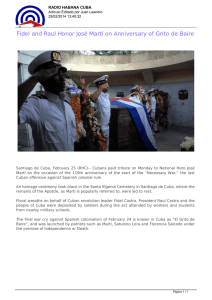
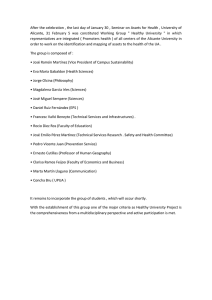
![29 † List of citizens newly attached [agregados] to the missions: To](http://s2.studylib.es/store/data/005935291_1-cce608f944c11df1f7b0591ad32e0ecf-300x300.png)
